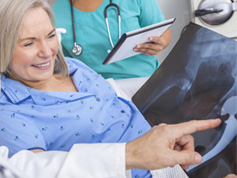A recent study has shown how important it is to take into account all those factors which might cause complications in hip surgery. I use the Optimized Postioning System in these cases, as it gives me so much more information about an individual patient’s anatomy.
The study shows how spinal deformity affects success of total hip replacement People with spinal deformity also requiring a total hip replacement are at greater risk for dislocation or follow-up revision surgery, suggesting that these higher risk patients may benefit from a more personalized approach to their surgeries to reduce the risk of poorer outcomes.
A new study led by orthopaedic surgeons at NYU Langone Medical Center provides a greater understanding of exactly how spinal deformity interacts with the pelvis, potentially increasing risk despite implanting the artificial hip in what is traditionally considered a “safe zone” by surgeons. “Surgeons should anticipate potential instability after performing a hip replacement in patients who have existing spinal deformity, and they should adjust their surgical plans accordingly,” says lead study author Aaron J.Buckland, MD, assistant professor of Orthopaedic Surgery in the division of Spine Surgery and director of spine research at NYU Langone. The study was presented March 17, 2017 at the American Academy of Orthopaedic Surgeons (AAOS) 2017 Annual Meeting in San Diego, California. These findings also were published online December 27, 2016 in the Journal of Arthroplasty.
More than 310,000 hip replacements are performed in the U.S. each year, with rates dramatically increasing over the past two decades in younger adults 45to 64 years of age who are active and living longer than ever before. An estimated 2.5 million Americans are currently living with hip replacements. Ina hip replacement, an artificial joint comprised of a ball and socket is implanted to replace the natural socket in the pelvis, enabling movement that is typical of the hip joint. For the past 40 years, surgeons have placed the socket (known as the acetabular cup) adjacent to the pelvic bone in a so-called “safe zone” a position that is thought to reduce risk of dislocation. However the new research suggests that placing the cup in the safe zone may not be enough to prevent dislocation in patients with spinal deformity.
Tags: arthritis, bilateral hip replacements, hip replacement, hip reserach, hip revision, hip surgery, revision surgery, Southampton

